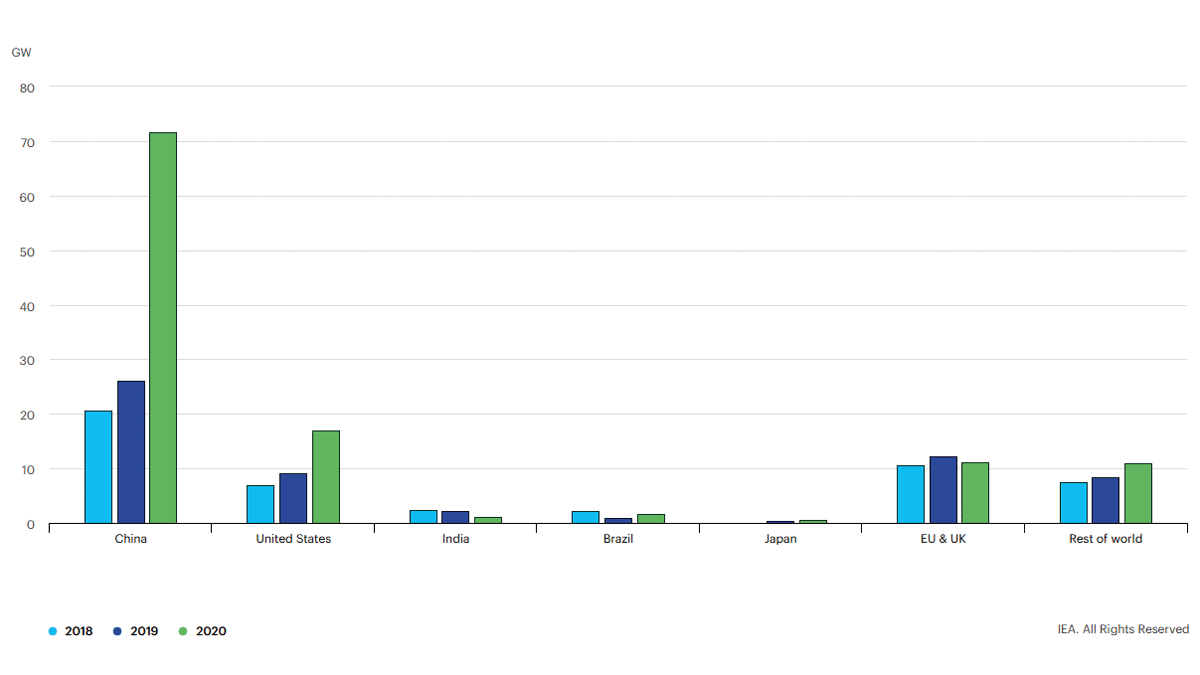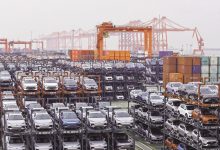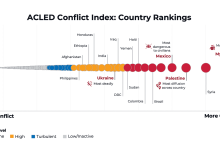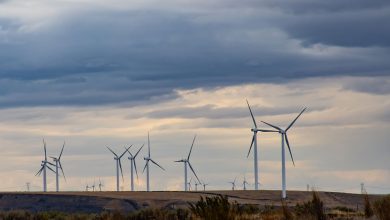To Continue or Not Wind Power Generation in Europe?
Over 250,000 large wind turbines are operational around the world, but their development is debated by experts. Should the development of this energy source be continued or disrupted?
Feedback of countries where wind turbines are predominant
Never before have there been so many wind turbines installed around the world as in 2020: in total, the new equipment can produce around 114,000 megawatts (MW). The best year so far was 2015, with 70,000 MW, according to a report of the International Energy Agency (IEA) on the renewable energy market (Renewable Energy Market Update). Despite the pandemic, twice more wind farms have been installed compared to 2019. This corresponds to a wind farm of 13 MW installed every hour on the planet. These 114,000 MW of wind power installed in 2020 represent over six times more than installed in France in twenty years (almost 18,000 MW).
IEA, generally moderate in its forecasts, expects the installation of 80,000 MW in 2021 and 2022. This wind power development concerns all continents and primarily Asia, China being global leader in this field. The United States rank second, with a record year in 2020 for wind power development. The UK, which has an entire industrial and port sector, is global leader in offshore wind power.
Wind power installed in France is relatively stable year after year, around 1,500 MW (the average of the last four years), i.e., twice less than that installed in Germany. We don’t find this stability in time in Spain, which alternates delays, but has great ambitions (it had tender calls for 6,300 MW of wind and solar power in 2021).
The global wind power market is of three types: onshore development (in over fifty countries), offshore development (in 10 countries), but now the market for the renewable of onshore wind farms as well, as it is nearing twenty years of operation and needs replacement with stronger and more efficient installations.
The development of variable renewable energy (wind turbines and photovoltaic panels for power generation) is primarily determined by economic reasons. Wind and solar costs per kilowatt-hour (kWh) are steadily declining, while conventional energy costs are rising: carbon tax on fossil fuels, nuclear safety standards.
European leaders: Germany, Spain, the UK
The countries with a strong development of wind power are those where there are regular wind corridors, of sufficient power and without people living nearby. The location of wind turbines responds primarily to a logic of storage and geographic availability of the wind resource. At global level, the United States of America and China have the largest installed capacity, while in Europe Germany is leader (63,000 MW at the end of 2020), followed by Spain (27,000 MW) and the UK (24,000 MW). France ranks fourth, with 18,000 MW of installed power, almost exclusively onshore (figures from Wind Europe, February 2021).
With an average of a quarter of the operating time, can the wind turbine be cost effective?
French renewable energy expert Paul Neau believes it is necessary to distinguish between two elements that are often a source of confusion in wind energy debates: the load factor, on the one hand, and the operating time, on the other hand.
The load factor is the ratio between the power generated (in kWh) and the installed power (in kilowatts, kW). It is around 25% for onshore wind power and easily reaches 405 for offshore wind power. Load factors increase steadily.
A wind turbine produces power in 80% and up to 90% of the time, at a variable power, depending on wind speed. It is a perfectly predictable production, which the network manager takes into account in the energy mix to meet the power needs of consumers, which are also variable. The precision of the forecast on electricity production by wind and solar power increases from year to year, on the one hand due to the progress in the weather forecast, on the other hand due to the feedback of experience.
The cost price of one megawatt-hour (MWh) of wind power is sustainable, as it does not depend on the evolution of fuel prices, but on wind. Moreover, the decommissioning costs are modest and taken into account upstream, as a wind turbine has no hidden costs like toxic waste for example. Moreover, it is a mature technology with feedback from at least thirty years of experience. The only unknown remains how much the wind resource will produce (production that can prove to be lower than expected), but this translates in essence into a longer amortization period.
The Energy Regulatory Commission (CRE) has launched several tenders for wind farm projects in there years (CRE deliberation no. 2021-141, May 2021). It retained 162 files, totaling 3,500 MW, at an average price of EUR 62.7/MWh. It should be noted that the new nuclear power is much more expensive, as evidenced by the European pressurized reactor (EPR) project at Hinkley Point in the UK, at over EUR 105/MWh.
Profitability
It all depends on what is meant by profitability. A wind turbine operates more than 80% of the time, but with variable production. Its actual production is estimated to be equivalent to what it would deliver if it operated at about a quarter of the time at full power, to supply more than 18,000 MW of installed capacity (more than 8% of France’s electricity, according to operator of the French electricity transmission network (RTE, 2020). This efficiency increases with the widening of the blades and straps of new generation machines. The performance is maximum at sea, where it exceeds 40% of rated power (produced in optimal operation). The onshore average must also be weighted according to the territories.
Economically, a wind turbine is very profitable
Project financing responds to a purely capitalist logic: very significant financing at the beginning (approximately EUR 1.3 million per MW), generally through debts to banks; then, once the projects have been validated, a very high return on investment, sometimes exceeding 10%, for fifteen to twenty years. For all farms before 2017, power is purchased at a fixed contract price, often well above market prices. This mechanism, designed to support an expanding industry, has resulted in the enrichment of large financial promoters and players. Today, the sector is becoming more and more mature, and the prices offered in the most recent auctions have dropped considerably. But previous contracts must be honored until they expire, and a ‘supplementary remuneration’ mechanism remains. This protects investors and operators during the direct sale of electricity: it is added to the proceeds of the sale as long as it has not reached market prices. The excess is then used to reimburse selling costs. According to a 2018 report by the Court of Auditors, it represents almost one billion euros a year financed by a share of the tax on electricity bills.
Are the benefits of wind turbines greater than the disadvantages (acoustic, visual)?
The noise of a wind turbine is mainly due to the blade tips that cut the air at about 250 km/h. The treatment of these extremities has gradually made it possible for the new generations of wind turbines to be less noisy than the previous ones. In particular, inspired by the wings of owls, these tips are equipped with a device (a kind of comb) to reduce emissions at the source. As with other potential inconveniences or impacts (creating projected shadows, collision with flying wildlife), another type of preventive action is restricted operation or temporary shutdown of the machine during periods of risk. For example, the wind turbine will operate at a slower rate, with lower power production, but especially with lower noise emissions, at certain sensitive times for the neighborhood, such as summer evenings.
Too often, electricity is seen as clean energy, regardless of its means of production, which are generally unseen. In the case of wind (or solar) power, production is decentralized. This production will generate local and reversible impacts, but not proportional to conventional, fossil, and nuclear means of production (climate change, soil pollution, production of highly toxic waste etc.). According to the noise regulations in force (the strictest European regulations), the noise pollution produced by wind turbines is limited to a total threshold of 35 decibels outdoors, in broad daylight.
Sleep disorders due to turbine noise
The problem is that this threshold does not take into account the nature of the sounds produced by wind turbines. But a rural environment, even with agricultural activity, does not produce mechanical and repetitive sound like that of wind turbines for hours. A recent study even revealed that their noise, even low, could be heard five times more often at night (known as the ‘swoosh’ effect) up to three kilometers away. This could explain sleep disorders reported by dissatisfied residents. The problem is finally starting to be taken seriously, as systematic noise control has been in place since the beginning of 2022.
Visual effect – hundreds of masts
For visual inconveniences, since 2011, the law only allows the installation of equipment more than 500 meters from the nearest homes, as for any installation classified for environmental protection (ICPE). But it does not set any limit for the number of wind turbines visible from a person’s home. If landscape impact studies are to indicate at least this ‘visibility’, this does not preclude the construction of a new farm. Thus, in some villages in Champagne or Hauts-de-France, the inhabitants confess the feeling of being surrounded by wind turbines, sometimes with up to 200 masts visible around a single village. The visual effect is also noticeable if the wind turbines are located in the axis of the sun, the shadow cast by the moving blades causing a so-called ‘stroboscopic’ effect, which is particularly unpleasant for homes.
Finally, regulations require each mast to be equipped with flashing light emitting diodes to signal the presence of wind turbines to aircraft, but due to lack of coordination between farms, these markers cause substantial light pollution, especially in sparsely populated areas.
Carbon footprint of wind turbines
RTE has compiled a carbon footprint balance for wind and solar power generation in France in 2019. The 45 terawatt-hours (TWh) produced by wind turbines avoided emitting 22 million tons of CO2 per year (5 million tons in France and 17 million tons in neighboring countries). Thus, every kWh of wind and solar power produced in France in 2019 avoided the emission of approximately 490 grams of CO2. In addition, the Ecological Transition Agency estimates that the emissions needed to produce wind power are between 12 and 15 grams of CO2 per kWh. These two results determine the net balance of production of one kWh of wind power, at about 475 grams of CO2.
Another way to characterize the energy balance, and therefore the carbon balance, is to calculate the energy recovery time. The latter is given by the number of months of operation required to payback the energy required for the manufacture of wind turbines, the construction of the farm, its operation for about twenty years and its dismantling. This energy payback time has been calculated by ADEME (Agence de la transition écologique): it is 6 to 12 months for onshore wind power and 7 to 14 months for offshore wind power.
CO2 emissions from wind turbines, lower than nuclear power, but higher than hydropower
In order to measure the full energy balance, it is necessary to perform an analysis of its entire life cycle (LCA), from resource extraction to recycling, including construction, maintenance and operation. The CO2 emissions mentioned by Paul Neau are slightly lower than those of nuclear (16 g CO2 equivalent/kwh), but higher than those of hydropower (4 g CO2 equivalent/kwh). Much of the impact of wind power on the environment is actually related to the extraction and construction of wind turbines. These require concrete, copper, aluminum, composite materials, but also electronic components (for the rotor) and, in less than 10% of cases, rare metals for certain types of magnets. At the end of its life, after twenty to thirty years of use, a wind turbine can be completely dismantled. While it was more than 90% recyclable, today it is no longer recyclable in the same proportions. Although promising, the processes of recycling the composite materials that make up the blades and recovering the metals from the rotor are still in their infancy.
Life cycle analysis does not take into account other effects of wind power. Thus, we can count the number of dead birds killed by blades, but this does not indicate the impact of a poorly located farm on the habitat of certain fragile populations, such as the eagle. Also, LCA does not take into account the effect of wind power on the sensitive and social relationship with a landscape and an environment. However, this report misses out on the political stakes: some economies of scale may have a low carbon footprint but may suddenly artificialize a large area. In contrast, citizen- and community-led projects may be better accepted and more directly linked to needs, but they take longer, and some may prove to be more ‘carbon-intensive’ and less competitive. The challenge of an energy policy is to know not only its cost and return, but also the uses from the energy produced, to whom it belongs and who benefits.
Wind power in Romania
An Erste Group study proved that Dobrogea region ranks second in Europe, after Scotland, in terms of wind power production potential.
Romania could increase by over four times its quantity of electricity produced annually by unlocking the potential of offshore wind resources, according to the study ‘Romania’s Offshore Wind Energy Resources’. The study identified a total natural capacity of 94 GW (94 million kW) of wind power in the Romanian offshore sector, of which 22 GW through turbines with fixed foundation on the seabed and the others through floating turbines. The annual production could reach 239 TWh (239 billion kWh), of which 54.4 TWh produced by turbines fixed on the seabed.
Offshore wind potential
In Europe, offshore wind projects have recently been built at about 60 km from shore, a distance that is right in the transition zone between shallow and deep waters in the case of Romania.
A large part of Romania’s exclusive economic zone consists of deep-water areas (over 50 m), being suitable only for floating turbines (installed on floating platforms). Wind speed increases with the distance to the shore, only the central part of the deep-water sector having higher average wind speeds (almost 7 m/s).
Nearly 6,000 MW of new wind projects could be operational in the next ten years, equivalent to an investment of about EUR 10 billion. At the moment, there are about 3,000 MW locally in wind projects, most of them in Dobrogea. Technological progress will allow the installation of these new units beyond the Dobrogea area, some of which will also have storage units, and network problems will be partially solved by increasing the interconnection capacity.
The study identifies two potential clusters with most favorable conditions for a first stage of offshore wind development, based on fixed turbines.
The first cluster allows a capacity factor of 33-35%, in water depths below 50 m at 40-60 km from the shore. (The capacity factor reflects the difference between the rated and actual capacity of a turbine at a given location, or the ratio of current to maximum power). This cluster strikes the right balance between wind resources and costs of the required offshore network, given the possibility to inject the output in the Constanta Sud electrical substation and the proximity to the Port of Constanta.
The second cluster presents marginally better wind resources, but the existing onshore power transmission line is further inland, and the connection grid would have to be extended through the Danube Delta, which is a protected area.
Offshore wind potential offers the prospect of investing in ‘green hydrogen’ production and consumption capacity as well as the creation of nationwide industrial value chains in the field of offshore wind and hydrogen, with a positive impact on the number of jobs nationally.
The studies analyze several problems to find a solution for the exploitation of offshore wind resources in the Black Sea, among which are:
- Network development to avoid overloading.
- Development of proximity ports, these being essential both in the manufacturing stage of certain components, but also in the installation, operation, and maintenance phases.
- The development by the government of the ‘Maritime Spatial Plan’ (MSP), with the involvement of all stakeholders and in accordance with the European Union MSP Directive. This plan is critical to avoiding the friction between potential maritime activities and strategic priorities.
- A regional framework for cooperation and integration with Bulgaria in this sector. A joint offshore wind project will be beneficial both for increasing the connection of the networks and for the perspective of the coupling of the electricity markets of the two Member States.
- Overcoming the limitations of the national power transmission system in the Dobrogea region, an area where significant onshore energy production capacities already operate, both renewable and nuclear, which will be supplemented, in turn, in the coming years.
Promises of offshore wind power in the Black Sea
Offshore wind power generation offers important advantages: a high number of operating hours, low variability and, consequently, lower forecast errors and lower balancing costs compared to onshore wind and solar power.
In 2020, Romania consumed 12.4% of wind power
Romania in 2020 reached the target of 24% of the total energy consumption coming from renewable sources. For 2030, the new target set by the Romanian Government is 30.7%, achievable by adding 7GW in renewable capacity. As for energy consumption, according to Eurostat data, in 2019, just over 24% of the energy consumption came from renewable energy sources, placing Romania the 10th in the EU and above the EU’s average level.
In 2020, electricity production in Romania came at a rate of 12.4% from wind sources, 3.4% from photovoltaic panels and 27.6% from hydro sources. In total, renewable energy production (wind, solar and biomass) accounted for 16% of the total.
Romania is slightly ahead in terms of the share of energy from renewable sources compared to the European Union average. At the same time, it is at the top of the EU countries in terms of coal dependence for electricity generation at a cost of about 50% above the average price in the energy market in 2020.







